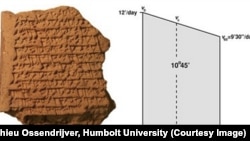Ancient Babylonian astronomers working in the pre-Christian era have long been thought to be way ahead of their time, employing arithmetical methods to predict the positions of celestial bodies.
But new evidence shows they also employed sophisticated geometry to chart the movements of Jupiter -- prefiguring the development of calculus.
Science historian Mathieu Ossendrijver tells RFE/RL that the finding "could probably redefine our history books about physics and mathematics," because the origins of the technique used by ancient Babylonians previously have been traced to the 14th century.
Ossendrijver, a professor at Humboldt University of Berlin, has analyzed five clay tablets from the British Museum and published the results of his research in the current issue of the U.S. magazine Science.
The five tablets engraved with their cuneiform writing system date from the period between 350 and 50 B.C., and were excavated late in the 19th century in Babylon, some 100 kilometers south of Baghdad, in modern Iraq.
None of them contains drawings, but Ossendrijver said the tablets describe a four-sided shape, called a trapezoid, representing how Jupiter's velocity appears to change with time based on its own and the Earth's orbits. The area of the trapezoid represents the distance traveled by Jupiter along its orbit.
The computations covered a period of 60 days, beginning on a day when the giant planet, equated with the Babylonian god Marduk, first appeared in the sky before dawn.
Professor Alexander Jones from the New York University, who was not involved in the study, describes it as "a new step in our understanding of the development of mathematical thinking in physical science."
Much was already known about ancient Babylon's astronomical achievements and its "extremely innovative tradition" in the centuries before Christ, Jones says, including to "predict the observable behavior" of the Sun, moon, and planets.
"But this particular discovery is showing that these temple-based scholars who were doing this kind of astronomy were thinking in a way about motion and changing speeds that is something that before now we thought had first shown up in Western Europe in the later Middle Ages."
Ossendrijver says the computations included on the tablets anticipate the use of similar techniques by 14th-century scholars at Oxford and in Paris.
"Not only do the tablets describe a graph of the velocity of Jupiter against the time, but these tablets also contain computations that show an insight into the connection between time, velocity, and distance -- a geometrical insight that we associate with integral calculus," he adds.
Also, it had been previously assumed that Babylonian astronomers used only arithmetical methods -- not geometrical ones -- even though they were common in Babylonian mathematics.
Ancient Greek astronomers from the time between 350 B.C. and A.D. 150 are known for their use of geometrical methods.
But Ossendrijver says the Babylonian tablets employ geometry in a more complex, abstract manner, describing figures that do not represent configurations in real space.
"When [the ancient Greeks] were doing geometrical astronomy, the geometry was actually spatial movement," New York University's Jones says. "You were looking at, for example, planets moving in paths that were combinations of circles. But the Greeks, as far as we know so far, did not do this kind of -- not a literal geometrical figure, but a kind of imaginary figure where one side is time."
